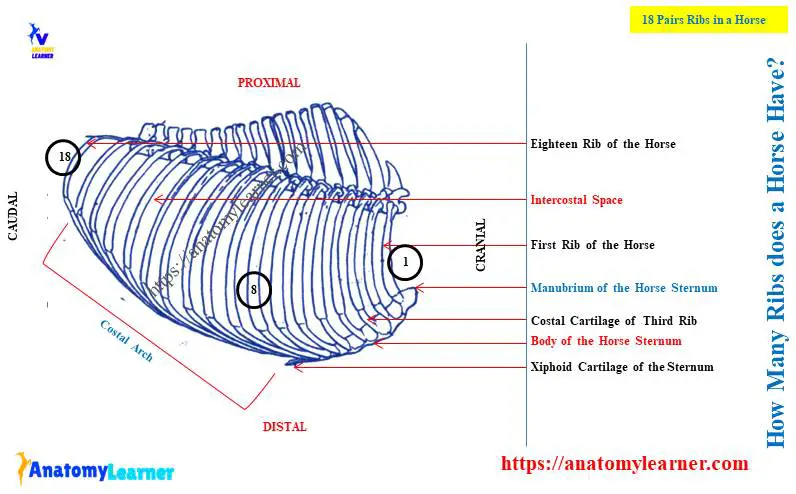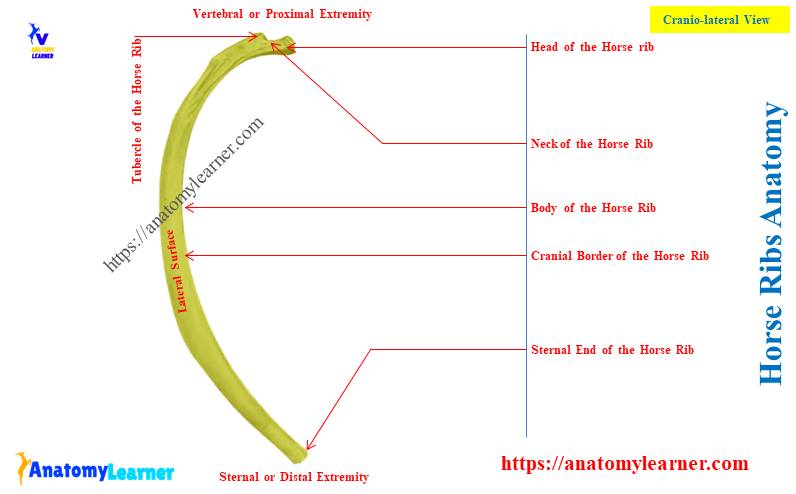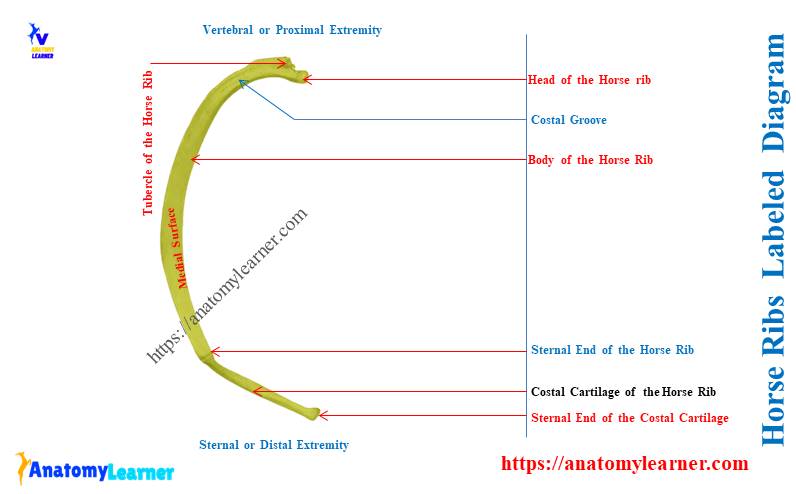The number of ribs in a horse varies compared to the dogs and cows. If you want to know the answer to a question – how many pairs of ribs does a horse have, you are in the right place.
I will show you the number of ribs from the horse axial skeleton with the diagram. You may also find a slight variation in the number of ribs in different horse breeds.
Quick answer: most of the horses have 18 pairs of ribs. But the Arabian horse has 17 pairs of ribs. The first 8 ribs are sternal, and the rest pairs (9/10) are asternal in the horse’s thoracic cage.
I will also share the anatomy of the horse ribs so that you may differentiate them from other species. So, let’s start to learn the number and anatomical features of the horse rib with the labeled diagram.
How many ribs does a horse have?
Horse ribs are curved elongated, modified long bones. They form the framework of the thoracic cage of the horse.
First, see the labeled diagram where I tried to show all the ribs from the horse’s thorax. If you count the ribs, you will find the number as follow (shown in Table 1) –
| Type of Ribs | How many ribs does a horse have? |
| Sternal ribs | 8 pairs (16) |
| Asternal ribs | 10 pairs (20) |
| Floating ribs | N/A (0) |
| Total ribs | 18 pairs (36) |
- So, the number of ribs in a normal horse – 18 pairs or 36 in total,
Where the first 8 pairs of ribs on both sides are asternal or true ribs. These asternal ribs are connected to the sternum directly through their costal cartilage. And this is why these 8 pairs of ribs from the horse thorax are the sternal ribs.
Again, the rest 10 pairs of ribs on both lateral aspects of the horse thorax are asternal. They reach the sternum indirectly by their costal cartilages, which join with the preceding cartilage.
But you will not find floating ribs in a horse’s thorax anatomy. The floating ribs are these single or paired ribs at the end of the series. They have no direct or indirect connection with the horse’s sternum bone.

In the case of the dog’s thorax anatomy, you will find the floating ribs. You may know more about dog ribs from the below-mentioned article –
How to count ribs from a live horse thorax?
You might count the number of ribs from the last rib of the live horse’s thorax. Thus, the last rib will be the eighteen-number rib.
Now, you should count them serially from backward to forward. This way, you may also count the intercostal spaces from the horse’s thorax.
The labeled diagram shows the counting method and intercostal spaces from the horse’s thoracic cage.
You will find 17 intercostal spaces in the normal horse.
Unique features of the horse ribs
You will find a little difference in the appearance of the horse ribs compared to the cows and dogs. Let’s see the unique features of the horse ribs that are mentioned below –
- Both 18 pairs of ribs of a horse possess the shaft and two extremities (vertebral and sternal ends),
- Typically the sixth rib shows more width compared to other ribs of this series,
- The eleventh rib shows the maximum length among 18 pairs of ribs,
- The shaft of the horse ribs are less wide and less flat compared to that of the cows,
- Again, the shaft of the horse ribs are band-like, whereas the cow shows a flatter body,
- Distance between the head and tubercle from the proximal end (vertebral end) is less than these of the cows,
Other features will be discussed in the horse ribs anatomy section. Ensure you know the features I have already mentioned from the horse ribs.
For your easy understanding, I will enlist and show the idea of osteological features from the horse ribs. Let’s identify the below-mentioned osteological features from the horse ribs –
- Vertebral and sternal ends (proximal and distal extremities),
- Less curved and band-like body,
- Head, neck, and tubercle from the vertebral end of the horse rib,
- Lateral and medial surfaces from the shaft of the horse ribs,
- Cranial concave and caudal convex borders of the horse ribs,
- Caudal distinct costal groove, and
- Enlarged articular surface and costal cartilage at the sternal end,
All these features mentioned above are identified in the horse ribs anatomy labeled diagram. You will find more labeled diagrams on horse ribs here.
Ribs count in other animals
As a veterinarian or animal owner, you might know the number of ribs from common domesticated animals. You will find 13 pairs (thirteen) of ribs in the ruminant like cows, sheep, goats, and others.
The dog also shows a similar number of ribs (13 pairs) as the cows and goats. But the pig may show a variable ribs (varies from 14 to 15 pairs) in their thorax.
The number of ribs in pigs depends on various breeds. Most of the pig species show 14 pairs of ribs in their thorax.
Again, you will also find a variation in the number of ribs in the rabbits. Typically a rabbit has 12 to 13 pairs of ribs in their thoracic cage structure.
Let’s see the number of total ribs, sternal, and asternal ribs from various animals in Table 2 –
| Species | Total ribs | Sternal ribs | Asternal ribs |
| Horse | 18 pairs | 8 pairs | 10 pairs |
| Cow | 13 pairs | 8 pairs | 5 pairs |
| Pig | 14 – 15 pairs | 7 pairs | 7 pairs 1 pair floating |
| Rabbit | 12 – 13 pairs | 7 pairs | 5 pairs |
| Dog | 13 pairs | 9 pairs | 3 pairs 1 pair floating |
Horse ribs anatomy
The horse ribs vary in length, width, and other features from first to eighteen. But they all possess the typical osteological features.
Here, in the horse ribs anatomy, I will represent the typical ribs from the series. Then I will describe the differences among these ribs from the horse thoracic cage.
What should you learn from the horse ribs anatomy? Well, you might learn the following from the horse ribs structure –
- Features of the proximal or vertebral extremity of the horse ribs,
- Shaft or body of the horse ribs, with their unique identifiable features,
- Features of the distal or sternal extremity of the horse ribs, and
- Unique features of the first and last ribs of a horse,
Let’s start with the anatomical features of the proximal extremity of the horse ribs structure.

The proximal extremity of the horse’s ribs
The other name for the proximal extremity of the horse ribs is vertebral ends. That is because this end connects with the body and transverse process of the thoracic vertebrae.
This vertebral extremity of the horse ribs possesses a head, neck, and tubercle –
- Head of the ribs – possess the articular surfaces and articulates with the body of the thoracic vertebra,
- The neck of the ribs – it is the constricted and roughened part between the head and tubercles, and
- Tubercles of the horse ribs – locates above and behind the junction of neck and head,
The articular surface on the head of the horse ribs consists of two convex facets. The median groove separates these cranial and caudal facets. Within this groove, the conjugal ligament attaches.
Finally, the two facets of the head articulates with the concave cavity formed by the adjacent bodies of thoracic vertebrae. The neck of the horse ribs is very short compared to the cows.
You will also find the oval articular surface on the tubercle of the horse ribs. It articulates with the facet of the transverse process of the corresponding thoracic vertebra.
Body of the horse ribs anatomy
Let’s see the unique features of the body of the horse ribs anatomy –
- It is an elongated structure,
- Relatively very narrow (band-like structure),
- Very strong and possess less curve,
But the curvature is more pronounced in the dorsal third. Again, the ventral part of the ribs is twisted and inclined inward.
Thus, the sternal end is raised when a horse rib is laid with its lateral surface on a table.
The body of the horse ribs shows two distinct surfaces and two borders. Here, the lateral surface of the body is convex in its length. You will find a longitudinal groove on the lateral surface of the body of a horse’s ribs.
The medial surface of the body is concave in its length. It is also rounded from side by side. In the diagram, I have identified the costal groove from the medial surface of the horse rib’s body.
This costal groove locates caudally on the medial surface. It is very distinct above and fades out the midline. Within this costal groove, the intercostal veins and arteries pass.
The cranial or anterior border of the shaft is concave. In contrast, the posterior or caudal border of the shaft of the horse rib is convex.

The sternal extremity of the equine ribs anatomy
The sternal extremity of the horse rib is enlarged and possesses an articular surface for the costal cartilage. No other important features were found in the distal or extremal extremity of the horse rib.
The costal cartilage attached to the distal end is cylindrical and a little compressed from side to side.
Now, let’s know about the costal cartilage of the horse ribs.
What is costal cartilage of the horse ribs?
The costal cartilage is the cartilaginous structure that connects the distal end of the ribs with the sternebrae. You will find the variation in the length of the costal cartilages for various ribs of the horse.
The length of the costal cartilage of the first rib is an inch or more. The very wide and thick dorsal end will be found in the first costal cartilage. Again, the sternal end of the first costal cartilage is small.
The costal cartilage of the other ribs increases progressively in length. It becomes gradually more rounded.
You will find enlarged and elliptical convex facets at the sternal end of this costal cartilage. Finally, these ends of the costal cartilage articulate with the sternebrae.
The costal cartilage of the asternal ribs of a horse is long, slender, and pointed. Most of the costal cartilage from asternal ribs overlaps and is attached by elastic tissue. Thus they together form the costal arch between the sternum and distal ends of the ribs.
First and last ribs of a horse
You may easily identify the first rib from the horse axial skeleton. It is very short, and the shaft widens significantly towards the sternal extremity.
You may get the full idea of the axial and appendicular skeleton of the horse from the below-mentioned article –
You will find a smooth impression at the lower part of the cranial border of the first rib. Within this impression, the brachial vein passes.
A small tubercle is in the structure of the horse’s first rib. But the head of the first rib is larger and possesses two unequal facets.
Here, the smaller facet faces cranially and articulates with the body of the last cervical vertebra. Again, the larger facet faces caudo-medially and joins with the body of the first thoracic vertebra.
You will not find any costal groove in the structure of the first ribs of a horse. The sternal end of the horse’s first rib is larger than any other ribs of the series. It is very thick, wide and turns a little forward.
The last rib of a horse is most slender and irregularly curved. It is also small, but its length is similar to the second ribs.
It is very hard to differentiate the head and tubercle from the last rib of a horse.
Changes in the horse ribs
Identifying the serial position of the horse’s ribs from its thorax is hard but possible. The length of the horse ribs increases from the first to the tenth. Then again, the size of the ribs diminishes from eleventh to eighteen.
Again, the width of the ribs increases in the sixth and then diminishes. From the second to the eighth ribs show a thin and sharp cranial border. But the other ribs show a thick and rounded cranial border.
The fourth to eighth ribs of the horse show a distinct lateral groove. You will find the great curvature of the ribs from the second to seventh and then diminishes.
You may quickly identify the head from the tubercle of the horse ribs. But the size of the head and tubercle diminish from first to last.
How to differentiate horse ribs from cows and dogs?
The curvature of the body and distance between the head and tubercle are unique for animal ribs. These features help you to differentiate horse ribs from cows and dogs. Let’s see the differentiating features of horse ribs from the cows and dogs (Table 3) –
| Features | Horse ribs | Dog ribs | Cow ribs |
| Numbers | 18 pairs | 13 pairs | 13 pairs |
| Floating ribs | Absent | Present | Absent |
| Body | Band-like Less curved | Narrow, thick Strongly curved | Wider, flatter Less curved |
| Head & tubercle | Distance – less | Distance – less | Distance – more |
How many ribs do Arabian horses have?
Arabian horses have 17 (seventeen) Paris of ribs in their thoracic cage. But the other normal horses never possess seventeen pairs of ribs.
17 pairs of ribs in a horse rarely happen. Sometimes in some of the horse breeds, you may find more ribs. You may occasionally find 19 (nineteen) pairs of ribs in the horse axial skeleton.
This is due to imperfectly developed thoracic vertebra and ribs. Sometimes a strip of costal cartilage may connect with the first lumbar vertebra by a ligament.
Again, the horse shows floating ribs (when 19 pairs) that attach to the costal cartilage of eighteen ribs. Except for the Arabian horse, when you will find 17 ribs, there may occur anomalies.
Sometimes, the first ribs in a few horses are imperfectly developed and do not reach the sternum.
Horse ribs Anatomy diagram
Now, let’s see every single osteological feature from the horse ribs anatomy labeled diagram. Here, I tried to show the features of the shaft and two extremities of the horse ribs.
I tried to identify the lateral and medial surfaces of the horse ribs in this diagram. Again, the diagram also shows the head, neck, and tubercles from the proximal or vertebral extremity of the horse ribs.
Again, the costal articular surface with the costal cartilage is identified from the distal end of the horse rib.
Here, I will help you to differentiate the head and tubercle from the horse ribs. The head of the horse ribs shows two articular surfaces or facets. In contrast, the tubercle shows only one facet in its extremity.
What animal has 26 ribs?
Domesticated animals like cows, sheep, goats, and dogs have 26 ribs. Among these 26 ribs, the first 16 ribs are sternal, directly articulating with the sternum.
But in dogs, the first 18 ribs are asternal as they directly articulate with the sternum by the costal cartilage. Rest ribs (10 or 8) are the asternal ribs that indirectly connect with the sternum.
Why do Arabian horses have less ribs?
You know the number of ribs equals the number of thoracic vertebrae. This is not always true, but most animals show a specific number of ribs.
The Arabian horse possesses 17 thoracic vertebrae, and thus, it also has less number of ribs. From the caudal part of the last cervical to the last thoracic, you will find 17 pairs of ribs.
Conclusion
So, you got the answer to the question – how many ribs does a horse have? The normal horse typically has 18 pairs of ribs. But sometimes, more or less ribs (17 or 19 pairs) may also occur in a horse.
The number of 18 pairs of horse also help you to differentiate the axial skeleton of a horse from others. Finally, the specific and unique features of these 18 pairs of horse ribs help you to identify them from cows and dogs.

